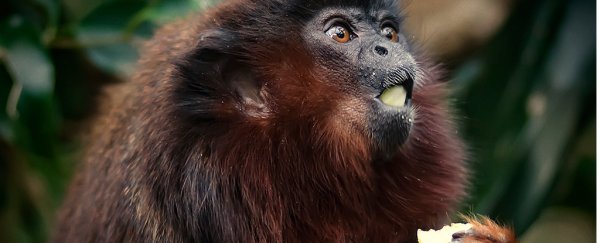When monogamous male monkeys see their mates with other males, it activates regions of the brain associated with social pain and pair bonding, a new study has found.
In an experiment involving eight captive male titi monkeys, researchers monitored brain activity for the first research into the neurobiology of monogamous primate "jealousy."
Jealousy is a curious state, and one that is difficult to study. It can cause a whole lot of problems, from insecurity and low self-esteem through to fear of abandonment and rage.
It can also reinforce romantic relationships, with people who self-report feelings of romantic jealousy also reporting, in general, higher relationship quality.
We aren't entirely sure why it happens, although there are theories that it has to do with mating and resources.
If we can learn more about the neurobiology of how primates respond to seeing their mates with potential rivals, though, perhaps that will give us a starting point to figure out how it works in humans.
"Understanding the neurobiology and evolution of emotions can help us understand our own emotions and their consequences," said lead researcher Karen Bales from the University of California.
"Jealousy is especially interesting given its role in romantic relationships - and also in domestic violence."
A lot of the research into monogamy has been performed on prairie voles, but for a brain a little closer to human, Bales's team turned to coppery titi monkeys, a monogamous primate from South America. In response to romantic rivals, male titi monkeys respond with aggression, sometimes even physically holding their mates back, Bales said.
The eight male monkeys were injected with fluorodeoxyglucose, a glucose molecule that fluoresces under PET-MRI.
These monkeys were then subjected to two different conditions: having to watch their female mate interact with a stranger male for 30 minutes; and having to watch a stranger female interact with a stranger male for 30 minutes.
When they watched their mates interact with stranger males, the monkeys showed increased activity in two regions of the brain: the cingulate cortex, which is associated with social pain in humans; and the lateral septum, which has previously identified as important for pair bonding, both in monkeys and voles.
"Previous studies identified the lateral septum as being involved in the formation of pair bonds in primates," said Bales. "Our research indicates that in titi monkeys, this region of the brain also plays a role in maintaining the pair bond."
They also experienced elevated levels of testosterone and cortisol, hormones associated with aggression and social challenge respectively.
But here's the thing. Using other primates for this sort of research and extrapolating the results onto humans will always be problematic.
We don't know that other primates experience emotions the same way that humans do, for instance, and we can't realistically map human experiences onto the behaviour of other primates.
In fact, the paper is careful to note this.
"We … cannot say definitively that the subjects in our experiment experienced the emotion of 'jealousy'", the researchers wrote in the paper.
"The higher testosterone concentrations … as well as the positive correlations between duration of time spent looking across at them and both cortisol concentrations and FDG uptake in the lateral septum, do suggest that this situation may have been viewed as a challenge to the pair bond or sexual relationship.
"However, it is worth noting that the emotion we attribute to the subjects was not shown unambiguously through behaviour."
Bales was also careful to point out that, while females also show jealousy, the study did not include any, and the neurobiology may be different.
But while different regions of the brain were affected for voles and monkeys, taken together they show that pair bonding involves regions of the brain associated with social memory and reward, and maintaining the pair bond as to do with avoiding the pain of separation, and that the hormonal neurochemistry is consistent across the board.
The research has been published in the journal Frontiers in Ecology and Evolution.
